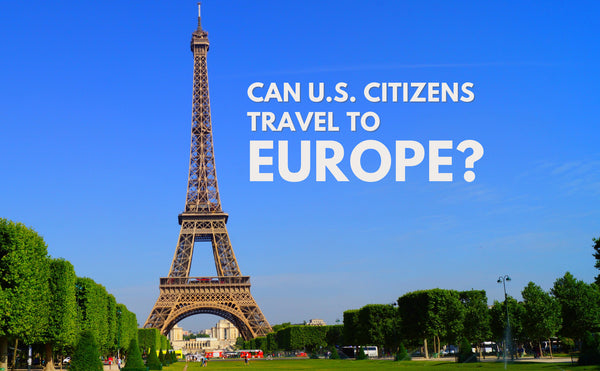Can US Citizens Travel to Europe? Here Is What You Need to Know before Making Travel Plans
Can US Citizens Travel to Europe? Here Is What You Need to Know before Making Travel Plans
The United States has been removed from the European Council’s approved countries list for entry, together with Israel, Kosovo, Lebanon, Montenegro and North Macedonia – leaving travellers with the question of whether Americans can travel to Europe or not, and whether they need to make any changes to their travel plans.
Following that, the countries in the EU and Schengen Area have responded to the recommendations and adjusted their own policies of who is eligible to enter. Some member states prohibit non-essential travelling purposes regardless of the vaccination status, some allow vaccinated travellers only, and some are open for both but with quarantine restrictions and COVID-19 testing requirements.

In this article from CabinZero, we will list out some examples of how some European countries have given out different restrictions for vaccinated and unvaccinated travellers arriving from the United States.
Are Americans still allowed to travel to Europe now?
Yes, but it depends on which country they are travelling to. Some countries are open to U.S. vaccinated travellers, some require an additional quarantine in place, some are closed for unvaccinated travellers, while some are entirely closed to U.S. citizens.
Why has the U.S. been removed from the European Council’s approved countries list?
There are certain epidemiological benchmarks of which countries can reach, they can be considered to be on the list of the European Council’s approved countries. Countries need to have no more than 75 new cases daily per 100,000 inhabitants in order to stay on the safe list. Unfortunately with the Delta variant wave, the U.S. has exceeded some of the benchmarks, therefore, it has been removed from the approved list.
What proof of vaccination do Americans need to enter Europe?
A paper vaccination certificate issued by CDC will be adequate as one of the entry requirements for American citizens who wish to enter a European country.
Where can Americans travel in Europe?
Austria
Vaccinated travellers are allowed to enter Austria with proof of vaccination (of an EMA-approved vaccine), no more than 270 days before arrival for one-dose vaccines or 360 days for two-dose vaccines and booster shots, or 180 days after testing positive for COVID-19.
Unvaccinated travellers must show proof of a negative test result (a PCR test taken within 72 hours before arrival or a rapid test within 48 hours before arrival), and will have to quarantine for 10 days.
Belgium
Vaccinated travellers are allowed to enter Belgium provided that they take a COVID-19 test upon arrival and quarantine until they receive the results. Travellers also need to fill in the Passenger Locator Form within 48 hours before arrival.
Unvaccinated travellers are currently not allowed to enter Belgium for non-essential travel purposes.
Bulgaria
Vaccinated travellers are not allowed to enter Bulgaria except for specific exceptional cases and proof of a valid negative pre-departure PCR test up to 72 hours before arrival.
Unvaccinated travellers are currently not allowed to enter Bulgaria.
Croatia
Vaccinated U.S. travellers are allowed to enter Croatia with proof of vaccination in the last 270 days or recovery from COVID-19.
Unvaccinated U.S. travellers are allowed to enter Croatia if they can show proof of a negative PCR test result no more than 72 hours before their arrival to Croatia.
Travellers with tourist reasons must show proof of booked accommodation for their stay upon arrival to Croatia.

Photo by Mich D on Unsplash
Cyprus
Vaccinated travellers are allowed to enter the island of Cyprus if they can provide proof of vaccination with an EU-approved vaccine, and also the Sputnik (Gam-COVID-Vac) or the Sinopharm (BBIBP COVID-19), or proof that they have had COVID-19 in the past 180 days. Passengers can upload these documents into the Cyprus Flight Pass up to 48 hours prior to arrival.
Unvaccinated travellers are allowed to enter Cyprus if they can provide a negative PCR test result taken no more than 72 hours before departure, and they will need to take another test upon arrival at their own expense.
The Czech Republic
Vaccinated travellers are allowed to enter the Czech Republic with proof of vaccination or recovery from COVID-19 in the past 180 days. They will also need to fill in the Passenger Locator Form before arrival.
Unvaccinated travellers are allowed but they must arrive with a negative PCR test, have to go through quarantine and take a PCR test not before day 5 of self-isolation.
Denmark
Vaccinated travellers with proof of vaccination of an EMA-approved vaccine or recovery from COVID-19 can enter Denmark without quarantine requirements.
Unvaccinated travellers are not allowed to enter Denmark for non-essential reasons. Unvaccinated visitors to Denmark for work or essential purposes must get tested upon arrival and enter quarantine. They can get out of quarantine with a negative test result on day four.
Estonia
Vaccinated travellers and people who have recovered from COVID-19 are allowed to enter Estonia. Unvaccinated travellers are currently not allowed.
Finland
Vaccinated travellers and people who have had COVID-19 are allowed to Finland. The vaccination certificates need to be in either English, Finnish or Swedish – translated certificates are allowed as well. They can also be an EU digital certificate.
Unvaccinated travellers are currently not allowed to enter Finland as follows this guide from the Finnish government.
France
Vaccinated travellers are allowed to enter France with proof of full vaccination. Children above the age of 12 must show a negative COVID-19 PCR test result.
Unvaccinated travellers are not allowed to enter France for non-essential travel reasons.

Photo by Soroush Karimi on Unsplash
Germany
Vaccinated travellers are allowed to enter Germany. They will have to fill in the Digital Registration On Entry before arrival.
Unvaccinated travellers are not allowed to enter Germany for non-essential purposes. If they intend to travel to Germany for work purposes, they can provide a negative COVID-19 PCR test result and must quarantine for ten days.
Greece
Vaccinated travellers are allowed to enter Greece without having to undergo any testing requirements.
Unvaccinated travellers are allowed to enter Greece with some requirements. They must provide a negative COVID-19 PCR test valid within 72 hours before departure, a negative RAT test result that has been taken no more than 48 hours before arrival, or they show proof of having had COVID-19 in the past 30-180 days. The Greek authorities are subject to conducting random testing for passengers arriving in Greece.
Hungary
Vaccinated travellers are allowed to enter Hungary with an EU Digital COVID certificate. If they can’t provide the certificate, they will have to show a negative PCR test result taken no more than 72 hours before arrival.
Unvaccinated travellers are allowed to enter Hungary if they can provide a negative PCR test result taken no more than 72 hours before arrival in an EU, OECD, NATO member state, or Russia, China, the UAE, Bahrain, or a Turkic council member state (Azerbaijan, Kazakhstan, Kyrgyzstan, Turkey, or Uzbekistan).
Iceland
Vaccinated travellers are allowed to enter Iceland with a negative test (it can be either PCR or rapid test) taken no more than 72 hours before departure. People who have recovered from COVID-19 who have their proof of a positive PCR test taken 14 to 180 days prior to the flight will not have to submit a negative test result upon boarding.
Unvaccinated travellers are allowed to enter Iceland with a negative PCR test result taken within 72 hours before departure, and they must go through a 5-day quarantine.
Ireland
Vaccinated travellers and people who have recovered from COVID-19 in the past 180 days are allowed to enter Ireland without any requirements.
Unvaccinated travellers are allowed to enter Ireland with a negative PCR test result taken no more than 72 hours before arrival, and must go through a 14-day quarantine period (they can ‘test out’ after day 5 with a negative test result).

Photo by K. Mitch Hodge on Unsplash
Italy
Vaccinated travellers are allowed to enter Italy with a negative COVID-19 test result taken no more than 72 hours before arrival (this can be either PCR or rapid test).
Unvaccinated travellers are allowed to enter Italy with a negative COVID-19 test result but they must go through a 5-day quarantine, even if the result is negative. They need to take another test on day 5 to leave quarantine.
Latvia
Vaccinated travellers are allowed to enter Latvia and unvaccinated travellers are not currently allowed to.
Lithuania
Vaccinated travellers are allowed to enter Lithuania if they have had one of the following vaccines: Comirnaty (Pfizer/BioNTech), Moderna, Janssen or Vaxzevria (AstraZeneca).
Unvaccinated travellers are allowed to enter Lithuania but they must show a negative PCR or antigen test result, and enter a 10-day quarantine. They can ‘test out’ on day 7.
All passengers must fill in a form within 48 hours before arrival.
Luxembourg
Either vaccinated or unvaccinated travellers from the U.S. are currently not allowed to enter Luxembourg.
Malta
Vaccinated travellers are allowed to enter Malta but unvaccinated ones are not.
The Netherlands
Vaccinated travellers are allowed to enter the Netherlands without the need to quarantine.
Unvaccinated travellers are not allowed to enter the Netherlands at the moment. However, if they have an essential reason to travel that falls under a specific category of circumstances of the EU , they need to undergo testing.
Norway
Either vaccinated or unvaccinated travellers from the U.S. are currently not allowed to enter Norway.
Poland
Vaccinated travellers from the U.S. are allowed to enter Poland without any quarantine requirements.
Unvaccinated travellers are allowed to enter Poland but they need to self-isolate for 10 days and they can ‘test out’ on day 7.
Portugal
Both vaccinated and unvaccinated travellers from the U.S. are allowed to enter Portugal. Passengers over 12 years of age should have an EU Digital Covid certificate or must show proof of a negative PCR COVID-19 test taken within 72 hours before departure, or a rapid test was taken within 48 hours.
All travellers from the U.S. must fill out a form , and if they get COVID-19 while in Portugal, they must enter a 10-day quarantine at their own expense.
Romania
Vaccinated travellers are allowed to enter Romania if they have been vaccinated at least 14 days before arrival or have had COVID-19 during the past 90 days, without the need to quarantine.
Unvaccinated travellers are allowed to enter Romania but they must self-isolate for 14 days, even with proof of a negative COVID-19 test result. They can ‘test out’ after day 10 if they test negative for COVID.
Slovakia
Vaccinated travellers coming to Slovakia for work purposes are allowed without quarantine. Otherwise, travelling for other reasons require quarantine.
Unvaccinated travellers are allowed to enter Slovakia but they have to quarantine for 14 days. They can ‘test out’ after day 8.
All passengers must fill in a registration form prior to arriving in Slovakia.
Slovenia
Vaccinated travellers are allowed to enter Slovenia with a negative COVID-19 test (either PCR or antigen test) taken within 72 hours prior to arrival. People who have recovered from COVID-19 are allowed if they have proof of COVID-19 no more than 90 days before arrival.
Unvaccinated travellers are not allowed to enter Slovenia except for business purposes and essential reasons.
All passengers must fill in a form prior to arrival.
Spain
Vaccinated travellers are allowed with a QR code on a Spanish portal .
Unvaccinated travellers from the U.S. are not allowed to enter Spain at the moment.

Photo by Henrique Ferreira on Unsplash
Switzerland
Vaccinated travellers from the US are allowed to enter Switzerland without further travel restrictions if they have received one of the following vaccines: Pfizer/BioNTech, Moderna, AstraZeneca, Janssen/Johnson & Johnson, Sinopharm/BIBP and Sinovac. People who have recovered from COVID-19 are also exempt from quarantine if they can provide proof that they have had the virus.
Unvaccinated travellers from the U.S. are not allowed to enter Switzerland for tourism purposes.
You can check this tool to see if you are eligible to enter Switzerland.
England
Vaccinated travellers are allowed to enter England without the need to quarantine but they need to undergo testing. The U.S. is now on the UK ‘amber list’, which means that passengers must show a negative COVID-19 test result and take another test on or before day 2 after arrival.
Unvaccinated travellers are allowed to enter England but they have to quarantine and undergo testing. They need to have a negative COVID-19 test result before departure and they will need to quarantine for 10 days upon the arrival. They will need to take a PCR test on day 2 and 8. They can ‘test out’ on day 5, but the costs could be expensive.
All passengers who arrive in the UK must fill in a Passenger Locator Form within 48 hours before arrival.
Europe Travel Advice For US Citizens
It is important to note that there are public health measures across all of Europe. There might be limited opening hours for some businesses, services, entertainment venues and tourist attraction sites. Some European countries have a curfew and other restrictions in place, including providing a COVID-19 pass to enter certain places. These mandatory restrictions are updated regularly so make sure you check them carefully before you make any travel arrangements.
U.S. citizens can find up-to-date information on COVID-19 travel guides on the U.S. State Department website’s COVID-19 travel information or detailed advisories for specific countries . The CDC also has detailed information for travelling during the pandemic for both vaccinated and unvaccinated travellers on their website .
Here Are The Current Travel Restrictions For Americans Traveling To Europe
Editorial Note: We earn a commission from partner links on Forbes Advisor. Commissions do not affect our editors’ opinions or evaluations.

Getty
Americans can still travel to European countries, although each country makes their own decisions about who can enter and what precautions are required to help prevent the spread of Covid-19.
Before deciding to travel to Europe, check the testing and vaccination requirements for your destination. Be sure to also consider any countries you transit as there may be testing or vaccination requirements even if you don’t leave the airport. You’ll also want to travel masks with you at all times, since some forms of transportation as well as public and private businesses may require them to enter. Many European countries specifically call for FFP2 masks (or similar-style masks such as KF94 or N95s).
Here are some of the latest European travel rules and restrictions for U.S. travelers.
Looking for Travel Insurance?
Compare Quotes With Over 22 Travel Insurers
France
U.S. citizens can travel to France with full proof of vaccination , which you may have to show to your airline and to border patrol.
Spain
U.S. citizens are not required to quarantine when arriving in Spain, but proof of vaccination or a recent negative test is required. Your test must be from within 72 hours prior to departure for PCR tests or 24 hours for antigen tests. Spain recently revised their requirements to define fully vaccinated travelers as those who received their final dose 14-270 days prior to arrival. Therefore, some travelers may need to obtain a booster dose prior to travel to Spain.
Before departure, you must complete a Health Control Form (FCS) and obtain and download the QR code to show at boarding and health controls upon arrival in Spain.
Requirements for Traveling to the U.S.
As of June 12, U.S. citizens returning from Europe to the United States no longer need to provide a negative Covid-19 test in order to return home. The Centers for Disease Control and Prevention (CDC) lifted the previous mandate that had required travelers to supply a negative Covid test or documentation of recovery in order to re-enter the U.S.
However, if you’re not a U.S. citizen or are on an immigrant visa, you’ll still need to show proof of vaccination to fly to the U.S. from Europe.
Get Travel Insurance Before Your Next Trip
Compare & Buy Travel Insurance
Was this article helpful?
- Best Covid-19 Travel Insurance
- Best Travel Insurance
- Best “Cancel For Any Reason” Travel Insurance
- Best Senior Travel Insurance
- Best Cruise Insurance
- Group Travel Insurance
- Best Travel Credit Cards
- How Much Is Travel Insurance?
- How To Get Cheap Travel Insurance
- Trip Cancellation Travel Insurance
- Medical Evacuation Coverage Guide
- Medical Insurance Guide
- Reimbursement For A Travel Insurance Claim
- Trip Cancellation Travel Insurance
- Annual Multi-Trip Travel Insurance
- Making A Travel Insurance Claim
- Trip Interruption Insurance
More from

Chase Sapphire Reserve: Dining Perks To Tempt Your Tastebuds
By Forbes Advisor Brand Group

Weekly Travel Insurance Costs And Trends: Week Of Nov. 20, 2022—United States, Mexico And Israel Are The Most Popular Destinations
By Michelle Megna Editor

10 Worst U.S. Airports For Flight Cancellations Last Week
By Kelly Anne Smith Forbes Advisor Staff

Best Travel Insurance Companies Of November 2022
By Amy Danise Editor

Best Covid-19 Travel Insurance Plans Of November 2022
By Amy Danise Editor

10 Worst U.S. Airports For Flight Cancellations This Week
By Kelly Anne Smith Forbes Advisor Staff

Travel Insurance Outlook For 2023: Hello, Big Spender
By Michelle Megna Editor
Information provided on Forbes Advisor is for educational purposes only. Your financial situation is unique and the products and services we review may not be right for your circumstances. We do not offer financial advice, advisory or brokerage services, nor do we recommend or advise individuals or to buy or sell particular stocks or securities. Performance information may have changed since the time of publication. Past performance is not indicative of future results.
Forbes Advisor adheres to strict editorial integrity standards. To the best of our knowledge, all content is accurate as of the date posted, though offers contained herein may no longer be available. The opinions expressed are the author’s alone and have not been provided, approved, or otherwise endorsed by our partners.
Becky Pokora is an avid traveler with a particular love for the outdoors. She’s always looking for new ways to make travel easier, more memorable, and more affordable, particularly by using miles and points.
© 2022 Forbes Media LLC. All Rights Reserved.
The Forbes Advisor editorial team is independent and objective. To help support our reporting work, and to continue our ability to provide this content for free to our readers, we receive compensation from the companies that advertise on the Forbes Advisor site. This compensation comes from two main sources. First, we provide paid placements to advertisers to present their offers. The compensation we receive for those placements affects how and where advertisers’ offers appear on the site. This site does not include all companies or products available within the market. Second, we also include links to advertisers’ offers in some of our articles; these “affiliate links” may generate income for our site when you click on them. The compensation we receive from advertisers does not influence the recommendations or advice our editorial team provides in our articles or otherwise impact any of the editorial content on Forbes Advisor. While we work hard to provide accurate and up to date information that we think you will find relevant, Forbes Advisor does not and cannot guarantee that any information provided is complete and makes no representations or warranties in connection thereto, nor to the accuracy or applicability thereof. Here is a list of our partners who offer products that we have affiliate links for.
Americans Will Need To Register Fingerprints And Be Photographed Traveling To Europe From 2023
This post may have affiliate links, which means we may receive a small commission (at no extra cost to you!) if you choose to purchase through them. Here’s our Disclosure & Privacy Policy for more info.
Share The Article
Last Updated 3 weeks ago
Europe is tightening security and clamping down hard on immigration. Besides the roll-out of a new travel authorization scheme, set to be implemented next year and making visits to the continent more bureaucratic, Brussels will soon start requiring foreigners to register fingerprints and be photographed when visiting.
This includes Americans.

For years, the European Union (EU) has mulled over introducing both an electronic visa waiver program in the mold of the United States’ ESTA, something described alternatively as an entry fee, as well as increasing surveillance at major entry points. Beginning in 2023, these plans will finally come to fruition – to the dismay of some.
Here is everything you need to know about the latest proposals coming from the European headquarters and what the implementation of the long-anticipated Entry-Exit System means for American tourists:
What Is The Entry-Exit System, And How Does It Affect U.S. Tourists?

The EU’s Entry-Exit System, shortened to EES, is described as an automated ‘IT system’ designed to register tourists arriving from third-countries – namely, non-EU nations like the United States, Canada, and the United Kingdom. Effectively, it will set the precedent for a fully-digital border, replacing passport stamps and lengthy border interviews.
Once the EES is up and running, travelers will have their dates of entry and exit out of Europe added to a shared database. Seeing that most foreigners are only allowed to spend 90 days out of every 180-day period within the zone, and date count is normally conducted via manual checks of passport stamps, this will strongly discourage ‘over-stayers’ from breaking the rule moving forward.

The caveat, at least for those concerned about privacy and the handling of their biometric data? It will result in non-European travelers being required to give their fingerprints and be photographed the first time they travel to or return to Europe after the EES is functional. This will be a one-off procedure.
The data will be stored by Frontex, the agency responsible for Europe’s border security, for any future visits.
How Will Registration Work?

Other than their facial features and fingerprints, the EES system will also require travelers to provide their full name and the type of document used for travel. Moreover, it will record ‘refusals of entry’, meaning American travelers in breach of the 90/180 rule may face serious problems traveling to Europe from 2023 (or worse, be punished with multiple-year entry bans).
As the European Commission puts it, they expect the EES to replace the current system of passport stamping. Officials have deemed it ‘time consuming’ and ‘unreliable’ when it comes to detecting over-stays. On the other hand, they claim it will help ‘bona fide‘ third-country travelers to enter Europe ‘more easily’, simply by scanning their way in.

The EES launches officially on May 2023, though a number of trials are already happening within Europe’s Schengen Area. The airport in Prague has begun registering passengers using the so-called ‘easykiosks’ from security company Secunet. As part of this trial, eligible tourists must follow the steps detailed below:
- Answer a short questionnaire displayed on the screen
- Give their fingerprints (four fingers)
- Capture a facial image
Is Europe About To See A New Wave Of Travel Delays?

Unless thorough checks are required, and excluding any errors, Prague Airport has reported an average time of 89 seconds. Time and smooth processing in airports are key, as you might have realized yourself last summer, and the introduction of the Entry-Exist System has understandably been a cause of concern for cross-border authorities.
With more than one minute added per processed passenger, wait times could increase dramatically across Europe’s border crossings next year, especially after May, when the first few rounds of EES registrations should take place. Authorities of the Port of Dover, the busiest border point between the U.K. and the EU, even warned of a chaotic summer of 2023.

Europe is aware of these concerns and has vowed to make EES implementation as seamless as possible. Prague, for instance, has installed 58 ‘easykiosks’ to handle a high ‘first-time visitor to Europe’ demand, as well as 17 ‘easygates’. We expect major transit hubs like Amsterdam Schiphol and Frankfurt International to install several more.
As for processing times in other hubs and other trials, we don’t have available data as of yet.
Are The EES And ETIAS The Same Thing, And Where Do They Apply?

The EES is a different thing altogether from Europe’s Travel Authorization scheme, or ETIAS. Visiting Europe from late 2023, besides undergoing biometric screening, Americans will be expected to request an ETIAS ahead of boarding – it costs roughly seven dollars to apply, and the authorization remains active, on a valid passport, for three years.
It is worth noting also both the EES and ETIAS apply exclusively to destinations within the Schengen Area, a collective of countries that either belong to the European Union, or are close partners, such as Switzerland and Iceland, which have formed together a customs union where internal border controls do not apply.
The EU, or its closely-associated Schengen Area, are not all of Europe.

Other European countries and territories not participating in the EES and ETIAS schemes, due to not being EU or Schengen members, include:
For queries relating to the Entry-Exit System, please refer to the official web page here.
↓ Join Our Community ↓
The Travel Off Path Community FB group has all the latest reopening news, conversations, and Q&A’s happening daily!

SUBSCRIBE TO OUR LATEST POSTS
Enter your email address to subscribe to Travel Off Path’s latest breaking travel news, straight to your inbox
This article originally appeared on TravelOffPath.com
Source https://www.cabinzero.com/blogs/our-journey/can-us-citizens-travel-to-europe
Source https://www.forbes.com/advisor/travel-insurance/travel-restrictions-us-europe/
Source https://www.traveloffpath.com/americans-will-need-to-register-fingerprints-and-be-photographed-traveling-to-europe-from-2023/